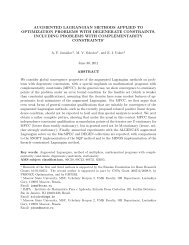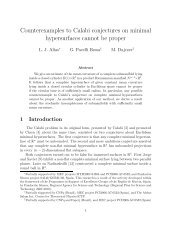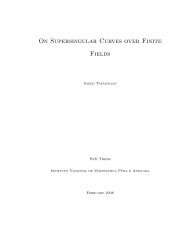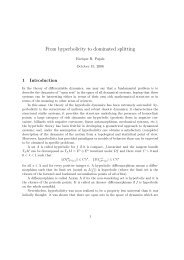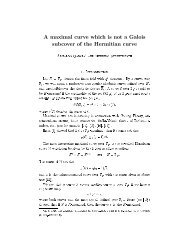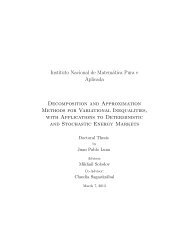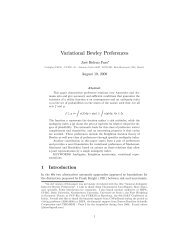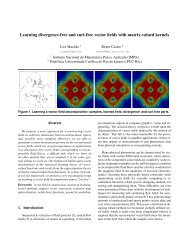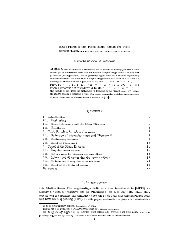Notes on Boussinesq Equation
Notes on Boussinesq Equation
Notes on Boussinesq Equation
You also want an ePaper? Increase the reach of your titles
YUMPU automatically turns print PDFs into web optimized ePapers that Google loves.
20 2. LINEAR PROBLEM<br />
Since φ ′ (ξ) ≠ 0, there exists ψ such that φ(ψ(ξ)) = ξ, ξ ≥ 0. Then making the change<br />
of variables η = φ(ξ) we have that<br />
∫<br />
I 1 =<br />
e itη ixψ(η) dη<br />
e<br />
ˆ˜f(ψ(η))<br />
φ ′ (ψ(η)) . (2.42)<br />
where ˜f(x) = f(x), for x < 0 and equals 0 otherwise.<br />
Taking the L 2 –norm of I 1 in t, using Plancherel’s identity and returning to the previous<br />
variables we have that<br />
‖I 1 ‖ 2 L 2 t<br />
= c<br />
∫ ∞<br />
−∞<br />
∫ ∞<br />
|e ixψ(η) ˆ˜f(ψ(η))|<br />
2<br />
|φ ′ (ψ(η))| 2 dη<br />
| ˆ˜f(ψ(η))| 2<br />
= c<br />
|φ ′ (ψ(η))| 2 dη<br />
(2.43)<br />
−∞<br />
∫ | ˆ˜f(ξ)|<br />
2<br />
= c<br />
|φ ′ (ξ)| dξ.<br />
A similar argument can be used to estimate I 2 . Hence the result follows.<br />
□<br />
Propositi<strong>on</strong> 2.11. Let V 1 (t) and V 2 (t) be defined as in the statements of Lemmas<br />
2.4 and 2.5, then:<br />
For f ∈ L 2<br />
( ∫ T<br />
sup<br />
x<br />
0<br />
|D 1/2<br />
x V 1 (t)f(x)| 2 dt) 1/2<br />
≤ c (1 + T 1/2 )‖f‖ 2 . (2.44)<br />
If h ′ ∈ Ḣ−1<br />
( ∫ T<br />
sup<br />
x<br />
0<br />
|D 1/2<br />
x V 2 (t)h ′ (x)| 2 dt) 1/2<br />
≤ c (1 + T 1/2 )‖h‖ −1,2 . (2.45)<br />
And for p ∈ L 2 ( ∫ T<br />
sup<br />
x<br />
0<br />
|D 1/2<br />
x V 2 (t)p ′′ (x)| 2 dt) 1/2<br />
≤ c (1 + T 1/2 )‖p‖ 2 . (2.46)<br />
Proof. To prove (2.44), (2.45) and (2.46) we shall use the same argument, so we <strong>on</strong>ly<br />
will sketch the proof of (2.44).



